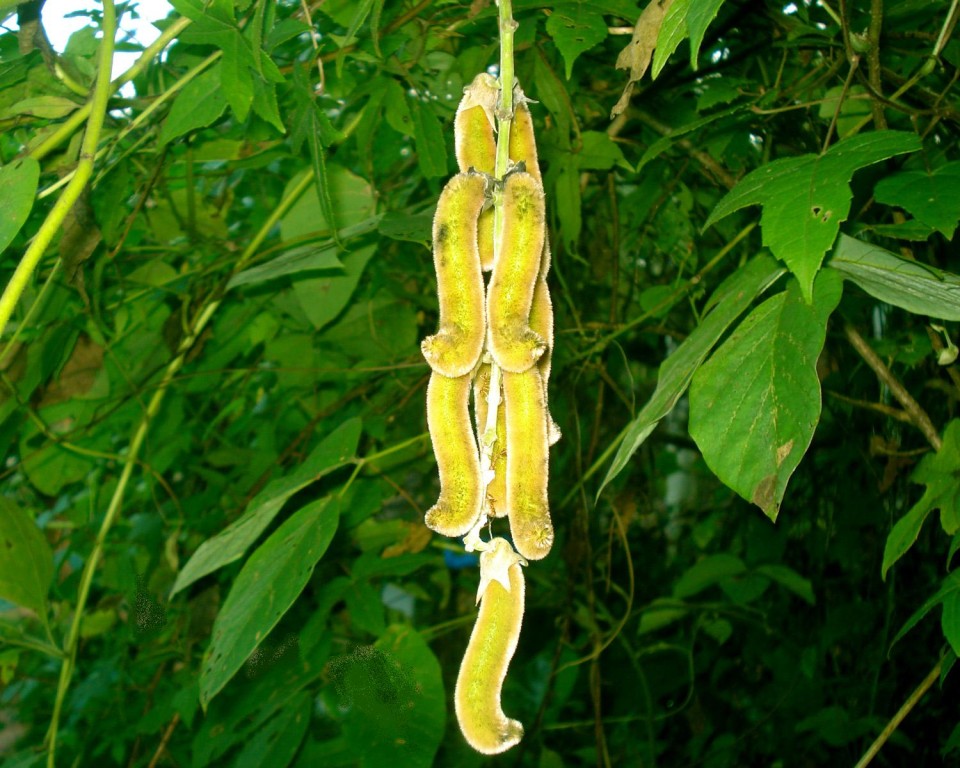
Botanical name: Mucuna pruriens, Papilionaceae (Fabaceae)
Other names: Ātmaguptā ‘concealed self’ (S), Goncha, Kevancha, Khujani (H), Punaikkali (T), Cowitch, Cowhage (E)
Botany: Kapikacchū is a climbing annual with slender, pubescent branches. The leaves are trifoliate, attached by a long petiole up to 12 cm long, the leaflets ovate, elliptic to rhomboid ovate, 7-15 cm long, the terminal leaflet slightly larger, the leaf surface pubescent above and densely covered in a silvery-grey hairs below, margin entire. The purple flowers are borne in elongated racemes of up to 30 flowers, giving rise to curved pods with longitudinal ribs, covered in brown or grey bristles, 5-7.5 cm long, each containing four to six black ovoid seeds. Kapikacchū is found throughout India, Africa and Southeast Asia (Kirtikar & Basu 1935, Warrier et al 1995).
Part used: Seeds.
Dravyaguṇa:
• Rasa: amla, tikta, kaṣāya, madhura
• Vipāka: guru
• Vīrya: uṣṇa
• Karma: medhya, balya, vajīkaraṇa, vātapittahara (Srikanthamurthy 2001, Warrier et al 1995)
Constituents: The most prominent constituent in Kapikacchū is L-dopa (3,4-dihydroxy-L-phenylalanine or 3-hydroxy-L-tyrosine), present in concentrations that range from a low of 1.81% for an accession named M. pruriens var. utilis grown in the USA, to a high of 7.64% for an accession named M. pruriens var. cochinchinensis grown in Bénin. It appears that L-dopa synthesis in the various cultivars is higher in plants grown at low latitudes, near the equator. Researchers have also identified a number of hallucinogenic indoles such as bufotenine, N,N-dimethyltryptamine and other tryptamines including serotonin, the latter of which is found in high concentrations in the bristles on the seed pods, which can cause profound skin irritation similar to a Nettle rash (hence the name ‘itcher of monkeys’). Other constituents include physostigmine, cyanogenic glycosides, trypsin and amylase inhibitors, tannins, lectins, and phytic acid. Several alkaloids have also been identified, including nicotine, mucunine, mucunadine, prurienine, prurienidine, prurieninine, as well as an oil comprised of stearic, palmatic, myristic, arachidic, oleic, and linoleic acid, phytosterols and lecithin (Burgos et al 2002, Kapoor 1990, St-Laurent et al 2002, Szabo & Tabbet 2002, Yoganarasimhan 2000).
Medical research:
• In vitro: anti-oxidant (Tripathi & Upadhyay 2002)
• In vivo: antidiabetic (Rathi et al 2002); antivenom (Aguiyi et al 2001)
• Human trials: Used after 28 days of pañca karma therapy, a formula comprised of of Mucuna pruriens, Hyoscyamus reticulatus, Withania somnifera and Sida cordifolia, decocted in cow’s milk, promoted a significant improvement in symptoms of Parkinson’s disease (Nagashayana et al 2000). An extract of Mucuna pruriens was found to promote statistically significant reductions in Hoehn and Yahr Stage scores and the Unified Parkinson’s Disease Rating Scale (UPDRS) scores in patients with Parkinson’s disease (Manyam 1995); compared with standard L-dopa/carbidopa, 30 g of Mucuna pruriens extract given to patients suffering from Parkinson’s disease led to a more rapid onset of action and longer effect without a concomitant increase in dyskinesia (Katzenschlager et al 2004).
Toxicity: A study examining the oral toxicity of Mucuna pruriens on albino rats for 30 days showed no toxic effect up to a dose of 600 mg/kg (Tripathi & Upadhyay 2002). Kapikacchū contains phytic acid, which binds to minerals in the gut thereby inhibiting their absorption, as well as lectins, which can promote gastrointestinal upset and inflammation. Some studies have shown GI upset to be a minor side-effect of higher doses.
Indications: Weakness, debility, consumption, wasting, asthenia, infertility, frigidity, spasm, tremor, chorea, Parkisonson’s disease, dementia.
Contraindications: Preexisting sensitivities to legumes, inflammatory bowel disease and irritable bowel syndrome.
Medicinal uses: Kapikacchū has long been valued in Āyurveda as one of the most effective vajīkaraṇa dravyāṇi, used in both men and women, but specifically male sexual dysfunction, such as erectile dysfunction, premature ejaculation, and sperm pathologies. To this end Kapikacchū is often combined with botanicals such as Gokṣura and Aśvagandhā for men, and with Gokṣura and Śatāvarī in the treatment of frigidity and leucorrhea in women. As an all-purpose vajīkaraṇa rasāyana the Bhāvaprakāśa recommends a formulation for a vaṭī (‘pill’) called Vānārī vaṭī, made by decocting one kuḍava (approx. 192 g) of the seed-pods in one prastha (approx. 768 mL) of cow’s milk until the milk becomes thick. The seeds are then removed from the pods and pounded, fried in ghṛta, and mixed with twice their weight in jaggery. The resultant preparation is then rolled into small pills and dosed at about 3-4 grams, twice daily (Srikanthamurthy 2000). Kapikacchū is also widely used in the treatment of almost any vāta disorder used to strengthen the mind and body in debilitated states, used in combination with botanicals such as Aśvagandhā, Āmalakī, Brāhmī and Jaṭāmāṃsī. It is an important remedy in many spasmodic afflictions, both topically and internally, including paralysis, hemiplegia and kampavāta (paralysis agitans). In the treatment of Parkinson’s disease Kapikacchū has shown benefit in clinical trials, used singly or in combination with botanicals such as Aśvagandhā, Balā, and Pārasikayavānī. Mixed with equal parts powders of Arjuna and Nāgabalā, Kapikacchū seed powder is fried in ghṛta and cooked with milk and sugar to make Kakubhādi modaka, used in the treatment of cough, bronchitis and consumption (Sharma 2002). As a member of the Fabaceae Kapikacchū contains many of the same constituents in beans that can promote gastrointestinal distress, and thus measures should be taken to include herbs with a pācana activity in formulation, such as Śūṇṭhī. The seeds are traditionally referred to as an antivenomous remedy against scorpion sting and snakebite, which has been validated by modern research. The hairs scraped from the pods are traditionally used topically as an irritant in fainting, and internally as a decoction in the treatment of intestinal parasites.
Dosage:
• Cūrṇa: freshly powdered dried seed, 3-10 g b.i.d.-t.i.d.
• Tincture: crushed seeds, 1:4, 25% alcohol, 3-15 mL